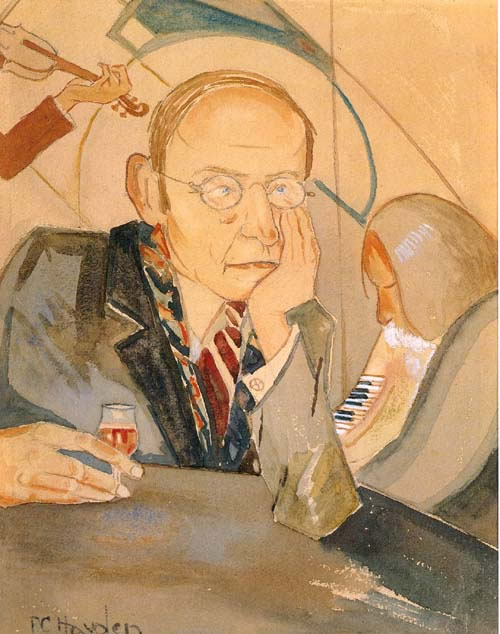
In Collection: Palmer Hayden, The Janitor Who Paints, 1930, Smithsonian American art Museum Washington.
About the work and Hayden (1890-1973):
By 1940 Palmer Hayden was known for his narrative scenes of New York’s urban life and the rural South. Like a photographer taking snapshots, he depicted black subjects during unguarded moments in their daily routine. His characterizations-sometimes humorous, sometimes unflattering-are nonetheless caring and proud. Described by Hayden’s compelling use of line, they possess the immediacy of popular illustrations.
 We Four in Paris, 30’s ?
We Four in Paris, 30’s ?
Although the artist’s studio is a time-honored theme, Hayden’s intention in The Janitor Who Paints (1930) is more provocative than usual because he described it as a “protest painting” in a 1969 interview. An easel, palette, and brushes share space with a bed, nightstand, feather duster, and broom. Is Hayden’s subject an amateur, painting portraits of his family and friends in his spare time at home? Or is he a professional artist, forced to support himself in a modest occupation and to combine his creative and domestic spheres in one setting? Having taken odd jobs including housecleaning to support himself, Hayden experienced the economic hardships of many black artists, and the painting has often been interpreted as both a self-portrait and a statement on adversity.
 The Subway, 1930.
The Subway, 1930.
The most immediate source for the element of protest that Hayden associated with the work, however, was his friendship with Cloyd Boykin, an older African-American painter who supported himself as a janitor: “I painted it because no one called Boykin the artist. They called him the janitor.” Hayden incorporated details such as the beret and the subject of mother and child to reinforce the sense of artistic identity, while the clock alludes to the workman’s schedule.
 Café de L’Avenue, 1932.
Café de L’Avenue, 1932.
Initially self-taught, Hayden sought training in New York and Paris, yet his style has frequently been described as primitive. In The Janitor Who Paints, the figures’ oversized hands and intense, cartoonlike expressions, as well as the freely treated space in which shapes are outlined as relatively flat areas of color, recall the simplified forms of American folk art. Actually, these elements owe as much to the broader influences of African and modern art that Hayden encountered in Paris as to his highly personal approach to interpreting the vitality and challenges of African-American life. (text Smithsonian)
Lynda Roscoe Hartigan African-American Art: 19th and 20th-Century Selections (brochure. Washington, D.C.: National Museum of American Art)

